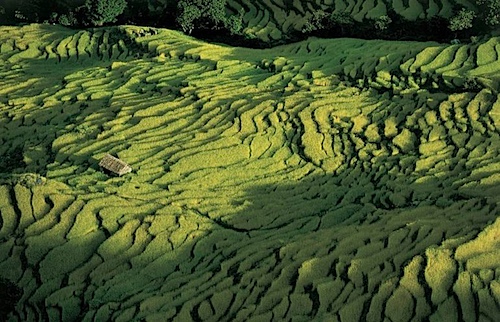- Dalmatian dog defect discovered.
- Better nutrition sneaked into school meals.
- Nebraska plans huge fry-up.
- Private-public partnerships needed to feed Africa. Huh?
Nibbles: Slow Food, Fonio, Origin of agriculture cubed, Domestication, Beer, Medicinal plants,
- Survival of the Tastiest. Via.
- Fonio Power.
- Tuberculosis linked to agriculture.
- Women’s caries linked to agriculture.
LowerHigher probability of reaching reproductive maturity linked to agriculture.- Dienekes discusses dog and cattle domestication papers.
- The African roots of medicine.
- Beer can be good for you. Who thought otherwise?
A landscape to marvel at
That image took my breath away when I saw it a couple of days ago. It shows rice terraces north of Pokhara, Nepal. The caption to the picture said that the economy of Nepal is based on agriculture,
“which employs 80 percent of the working population and accounts for 41 percent of the gross domestic product of one of the world’s poorest countries. Generations of farmers have tamed the mountainsides and prevented erosion by cutting terraces. Rice paddies thus rise in tiers as high as 9,800 feet (3,000 m) above sea level, covering 45 percent of Nepal’s cultivated land.”
The photo was one of almost 40 at a wonderful site called The Big Picture at boston.com. Two or three times a week Alan Taylor assembles a portfolio of outstanding photographs from around the world. This time they were by Yann Arthus-Bertrand, who has developed a wonderful technique of photographing nature and humanity from the air.
Many of the pictures that The Big Picture showcased depended for much of their impact on agriculture, and the patterns that human interference creates on the ground. This particular one caught my eye for two reasons. First off, it is very, very beautiful. Secondly, Pokhara is a famous name among some agrobiodiversity nuts (such as myself). I’ll explain in a minute. So, I made a note to come back and blog the story here when I had a moment. Imagine my horror, then, when I headed over to The Big Picture and found this note:
At the request of the coordinator of Yann Arthus-Bertrand’s upcoming exhibit, the number of photographs displayed here has been reduced to ten.
Pokhara had vanished. Yikes! That’ll teach me to procrastinate. But, knowing as I do the Dark Side of the Web, I simply assumed that someone, somewhere, would already have stolen it, and I was right. Lock, stock and barrel, the entire sequence of 38 images had been scraped by a nefarious site (to which I will naturally not link). They’d even had the gall to put their own credit on the image, a matter of minutes to excise. So, saved, by evil. ((It is, of course, not Evil to do exactly the same thing and steal back the photo for Good.))
Which brings me to the importance of Pokhara. The farmers there have been working with a local NGO called LI-BIRD and with Bioversity International to develop a local landrace of rice. After a concerted effort to find and then assess hundreds of versions of the landrace, the farmers came up with an improved version that was eventually registered with the Nepalese authorities as a “proper” variety that can be sold. That may not sound like much of an achievement, but take it from me: it is. But I had never seen the agricultural landscape in which this work was undertaken. Now that I’ve seen Arthus-Bertrand’s picture, I’m even more impressed.
You can read about Pokhareli Jethobudho at the web site of Bioversity International and at the International Development Research Centre in Canada, one of the donors that supported the project.
Big Men seek your attention
Following the terminology popularized by the puncuated equilibrium vs gradualist argument in evolution, one could, I suppose, characterize the two positions as collecting by jerks and collecting by creeps.
Way, way too good to be left languishing in a comment to a post that is almost a year old, I take the liberty of promoting Luigi’s remark to where it might amuse a few more people. What is he talking about? Sir Walter Raleigh, Peter the Great, Captain Bligh and Thomas Jefferson. Big Men, all of them, and stock figures in what Luigi calls the Big Man meta-narrative of plant introductions. Are there others? You tell us.
Nibbles: Fungi, Early warming, Food banks, High concept, Russia, Wine, Apples, China, Sustainable ag
- Vesicular arbuscular mychorriza help improve fallows.
- Google.org has a Predict and Prevent Initiative to catch outbreaks of human diseases before they happen. Would be nice to have something similar for threats of erosion of agrobiodiversity.
- Niger’s soudure food banks: could they act as village-level genebanks?
- You might call it meta-farming—the quasi-philosophical approach to raising crops and livestock that proceeds not from necessity or commercial aims but a concept.
- Farming in Russia: a slide show with narration.
- Army worm wine. WTF? Via. (They’re caterpillars.)
- A Kazak apple a day keeps the blue mold away.
- Neolithic China: not just rice.
- The oldest continuous cotton experiment in the world.
